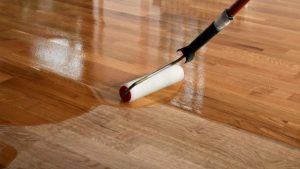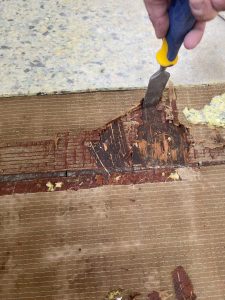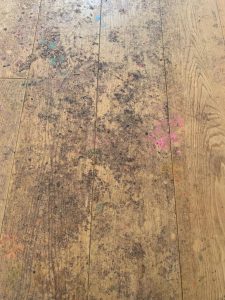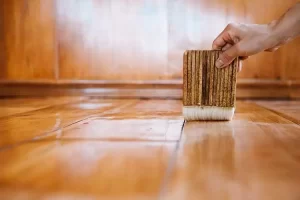How to Handle Floor Stains from Pets

Pets bring joy and companionship to our homes, but they can also cause stains on hardwood floors. Managing these stains promptly and effectively is crucial to maintaining the beauty and longevity of your floors. In this guide, we provide expert tips on how to handle floor stains from pets, ensuring your London home remains attractive and well-maintained.
Identifying Common Pet Stains
Understanding the type of stain is the first step in treating it effectively. Common pet stains include:- Urine Stains: These can cause discoloration and a strong odor if not addressed quickly.
- Vomit Stains: The acidic nature of vomit can damage the finish and the wood itself.
- Food and Drink Spills: Pets often knock over their food and water, leading to potential stains and water damage.
Immediate Actions to Take
Acting quickly can prevent stains from setting and becoming more challenging to remove:1. Blot the Spill
Use a clean, absorbent cloth or paper towel to blot the spill immediately. Avoid rubbing, as this can spread the stain and push it deeper into the wood.2. Clean with a Mild Solution
For urine and vomit stains, clean the area with a solution of water and mild dish soap. Dampen a cloth with the solution and gently wipe the stain, then rinse with a clean, damp cloth and dry thoroughly.3. Use Vinegar for Odor Removal
If the stain is accompanied by a strong odor, a mixture of equal parts white vinegar and water can help neutralize it. Apply the solution to the stained area, let it sit for a few minutes, and then blot it dry.Deep Cleaning and Stain Removal

For stubborn stains that do not respond to immediate cleaning, deeper treatments may be necessary:1. Hydrogen Peroxide Treatment
Hydrogen peroxide can be effective for removing deep stains and disinfecting the area. Dampen a cloth with hydrogen peroxide and place it over the stain. Cover with plastic wrap and leave it overnight. In the morning, remove the wrap and cloth, then rinse and dry the area.2. Baking Soda Paste
Baking soda can help lift stains and eliminate odors. Mix baking soda with water to form a paste, apply it to the stain, and let it sit for a few hours. Gently scrub with a soft brush, rinse, and dry the area thoroughly.3. Sanding and Refinishing
For severe stains that penetrate deep into the wood, sanding and refinishing the affected area may be necessary. Sand the stained area lightly with fine-grit sandpaper, clean the dust, and apply a matching wood finish or stain.Preventive Measures
Preventing stains is easier than removing them. Consider these preventive measures to protect your floors:1. Use Floor Mats and Rugs
Place mats under pet bowls and in areas where your pet frequently rests. This can help catch spills and prevent stains from reaching the floor.2. Clean Up Spills Immediately
Train yourself to clean up spills as soon as they happen. Quick action can prevent stains from setting and becoming more challenging to remove.3. Regular Floor Maintenance
Regularly clean and maintain your floors using appropriate wood floor cleaners. This helps protect the finish and keeps your floors looking their best.Conclusion
Handling floor stains from pets requires prompt action and the right techniques. By following these expert tips, you can effectively manage and prevent pet stains, ensuring your hardwood floors in your London home remain beautiful and well-maintained. For professional floor maintenance and stain removal services, contact our experienced team today. We are dedicated to helping you keep your floors in top condition, even in a pet-friendly home.








How to Deal with Floor Squeaks: Sanding and Repair Tips
How to Deal with Floor Squeaks: Sanding and Repair Tips Ensure Quiet and Smooth[Read more...]
Floor Board Restoration
Restoration Whilst you may believe that floor sanding itself is classed as restoration, floor restoration[Read more...]
How to Maintain the Shine on Your Sanded Floors
How to Maintain the Shine on Your Sanded Floors Expert Tips for Keeping Your[Read more...]
The Impact of Floor Sanding on Indoor Air Quality
The Impact of Floor Sanding on Indoor Air Quality Maintain a Healthy Home Environment[Read more...]
Floor sanding and renovation and installation services in Harlow
Harlow, located in Essex, is a thriving town with a rich history and a strong[Read more...]
Sep
Expert Tips for Maintaining Sanded Floors
Sanding your wooden floors can breathe new life into your home, giving it a fresh,[Read more...]
The Role of Floor Sanding in Home Staging
The Role of Floor Sanding in Home Staging Enhance your London home’s appeal with[Read more...]
WOOD FLOORING SANDING AND OILING
[Read more...]
Staining and Colouring
[Read more...]
How Floor Sanding Can Transform Your London Home
Living in London comes with the charm of historic architecture and classic interiors. However, maintaining[Read more...]